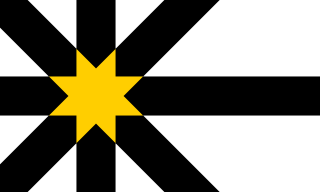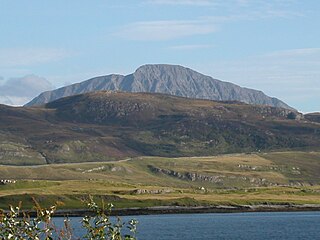
The Pentland Firth is a strait which separates the Orkney Islands from Caithness in the north of Scotland. Despite the name, it is not a firth.

The Castle of Mey is located in Caithness, on the north coast of Scotland, about 6 miles (10 km) west of John o' Groats. In fine weather there are views from the castle north to the Orkney Islands.

Sutherland is a historic county, registration county and lieutenancy area in the Highlands of Scotland. Its county town is Dornoch. Sutherland borders Caithness and Moray Firth to the east, Ross-shire and Cromartyshire to the south and the Atlantic to the north and west. Like its southern neighbour Ross-shire, Sutherland has some of the most dramatic scenery in Europe, especially on its western fringe where the mountains meet the sea. These include high sea cliffs and very old mountains composed of Precambrian and Cambrian rocks.

Caithness is a historic county, registration county and lieutenancy area of Scotland.

Dunnet Head is a peninsula in Caithness, on the north coast of Scotland. Dunnet Head includes the most northerly point of both mainland Scotland and the island of Great Britain.
Achairn Burn, known also as Haster Burn, is one of the major tributaries of Wick River, in Caithness, in the Highland area of Scotland. The burn's source is in headwaters flowing from the northern slope of the Hill of Toftgunn, which rises to over 170 metres, and in Camster Loch, which is at nearly 120 metres, between the Hill of Toftgunn and Ballharn Hill. The same area feeds also another major tributary of Wick River, the Camster/Rowans-Strath Burn. Achairn Burn enters Wick River at Mary Ford, about 10 kilometres to the northeast of the burn's source. Its entire course is within Caithness, as is the whole of the catchment basin of Wick River.
Loch Burn is a stream that flows out of the eastern end of Loch Watten in Caithness, in the Highland area of Scotland, at a height of around 20 metres and about one kilometre north/northeast of the village of Watten. Less than a kilometre east of its source at Loch Watten the burn flows into Wick River.

The River Thurso has Loch Rumsdale in Caithness as its source, about 26 kilometres south and 14 kilometres west of the burgh of Thurso, Caithness, and about 2 kilometres south of the railway line linking the burghs of Thurso and Wick with Inverness. At its source and until it reaches Loch More the river is known also as Strathmore Water. Caithness is in the Highland area of Scotland.

The A882 road is entirely within Caithness in the Highland area of Scotland. It has a length of about 23 kilometres (14 mi) and runs generally west/northwest from the A99 in the county town of Wick to the A9 in the Georgemas area.

Achavanich is an unusual megalithic horseshoe-shaped structure near Loch Stemster in Caithness, Scotland. Meaning "field of the stones", 36 of the original 54 remain today, mostly on the western side of the structure. The arrangement of these stones is extremely rare as the slabs are pointing towards the centre of the circle, rather than the typical side-by-side arrangement. The angle of the stones themselves is also strange. In most British stone circles, stones face the center with flat sides, but Achavanich's stones face the row at 90 degree angles. The stone circle remains open like a letter U, and evidence suggests it never was closed. The largest of the 36 remaining stones stands at only 2 meters, with an overall average of 1.5 meters tall. Although the site stood for several decades neglected and overgrown within a fenced off area which visitors were requested not to enter, access has recently been vastly improved with the clearance of the site, the repositioning of fence boundaries and the installation of information boards.

Skarfskerry is a settlement located in the far northern county Caithness on a small peninsula northeast of Thurso off the A836 in Scotland. It is the most northerly settlement in Great Britain. The name comes from the Old Norse for "cormorants' rock". Historically, it belonged to the Parish of Dunnet, along with Brough.

Ben Hope is a mountain in northern Scotland. It is the most northerly Munro, standing alone in the Flow Country south-east of Loch Hope in Sutherland. The mountain is a roughly triangular wedge, with a great crag on the west, with two lower shoulders to the south and northeast. Alpine flowers are abundant in season, although the ground is very rocky.
This is a list of the extreme points and extreme elevations in Scotland.

Mey is a remote village, located on the north coast of Scotland in Caithness, Scottish Highlands and is in the Scottish council area of Highland.

Wolfburn distillery is a Scotch whisky distillery in Thurso, Caithness, Scotland. After ceasing production in the 1860s, a new distillery of the same name opened in 2013.
Events from the year 1952 in Scotland.

Harrow is a hamlet on the north coast of Caithness, Scotland. It lies just to the west of the Castle of Mey and northeast of the Loch of Mey. Harrow Harbour, also called Philips Harbour, was built in the 19th century by the Earl of Caithness for exporting the local flagstone slabs. The harbour was restored in 1978–79 by the Highland Council and is used today by a few crab and lobster fishermen. During the restoration works Alexander (Derry) Ross, who had spent several years at sea and was now working on the project, used his Stanley knife to carve images of fishing vessels in the concrete of the sea wall before it set. Originally brightly coloured these are now faded but are still visible. On completion of the works Jimmy Page carried out the official opening ceremony and a plaque commemorating this is mounted on the harbour wall.

Caithness Lochs is a protected wetland area in the historic county of Caithness in the far north of Scotland. With a total area of 1,379 hectares, it covers six freshwater lochs and a complex area of fen and swamp, and has been protected as a Ramsar Site since 1998.
Dunbeath Water is a short river in Caithness in northern Scotland. It rises at Loch Braigh na h-Aibhne in the Flow Country and initially flows northeast before turning generally south-southeastward to flow through Dunbeath and into the Moray Firth at Dunbeath Bay. Its main tributaries in its upper catchment are the left-bank ones of Allt a' Bhuic which drains Loch Dubh and the Raffin Burn which drains Loch Breac. On the western edge of Dunbeath, the Burn of Houstry, fortified by the Allt an Learanaich also enter on the north bank. The river is crossed by the old bridge and a new bridge carrying the modern A9 road northwards. A small harbour has been developed at the river mouth.














